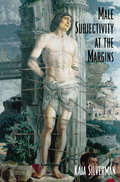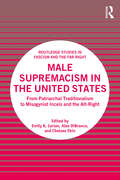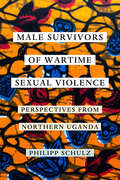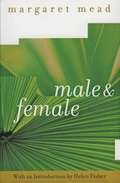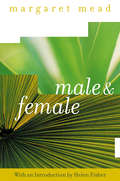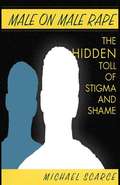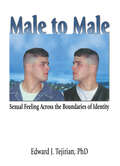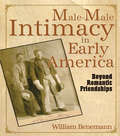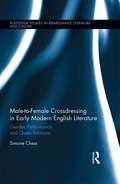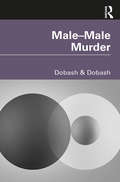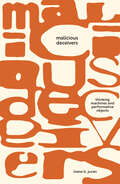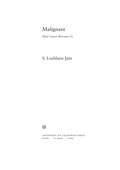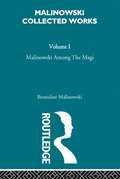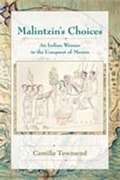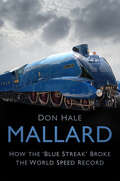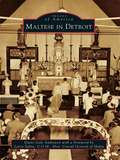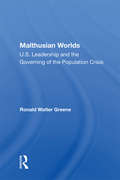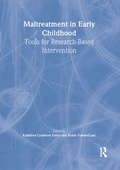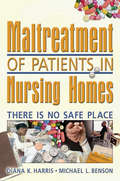- Table View
- List View
Male Subjectivity at the Margins
by Kaja SilvermanThrough the examination of a range of literary and cinematic texts, from William Wyler's classic The Best Years of Our Lives to the novels of Henry James, Silverman offers a bold new look at masculinities which deviate from the social norm.
Male Supremacism in the United States: From Patriarchal Traditionalism to Misogynist Incels and the Alt-Right (Routledge Studies in Fascism and the Far Right)
by Emily K. Carian Alex DiBranco Chelsea EbinMale Supremacism in the United States is a timely editorial collection providing analysis of current patriarchal, misogynistic, and antifeminist threats in the United States, The book theorizes how male supremacism—the system that disproportionately privileges cis men and subordinates women, trans men, and nonbinary people—and its accompanying ideology of male superiority undergird many of the most crucial phenomena of our time. The book examines how male supremacism manifests in three ways: as patriarchal traditionalism, as secular male supremacism, and in its intersections with other systems of oppression. From anti-abortion activism to misogynist incels to the Proud Boys, the collection illustrates how male supremacism plays a vital role in right-wing recruitment and organizing. The volume’s contributions illuminate unique aspects of male supremacist ideology, practice, and culture. Together, they provide a sweeping overview of the development and deployment of male supremacism in the United States. This book will be of value to anyone studying or researching male supremacism, gender, feminism, women’s studies, hate studies, and the far right.
Male Survivors of Wartime Sexual Violence: Perspectives from Northern Uganda
by Philipp SchulzA free open access ebook is available upon publication. Learn more at www.luminosoa.org. Although wartime sexual violence against men occurs more frequently than is commonly assumed, its dynamics are remarkably underexplored, and male survivors’ experiences remain particularly overlooked. This reality is poignant in northern Uganda, where sexual violence against men during the early stages of the conflict was geographically widespread, yet now accounts of those incidents are not just silenced and neglected locally but also widely absent from analyses of the war. Based on rare empirical data, this book seeks to remedy this marginalization and to illuminate the seldom-heard voices of male sexual violence survivors in northern Uganda, bringing to light their experiences of gendered harms, agency, and justice.
Male and Female in Developing South-East Asia
by Wazir Jahan KarimThis provocative book seeks to redress inaccuracies in Western perceptions of gender relations in Southeast Asia by bringing to the fore the area's ethnic and cultural variance and showing how women and men explain the informal and psychological dimensions of relationships as vital in holding family, neighbourhood and kinship ties together. Although there are differences between male and female perceptions of sex roles in society, women perceive their situation as disadvantaged rather than less significant. Male-female interpretations of power and status tend to converge usually towards the understanding that the contributions of men and women are equally important in the formation of family and society.
Male and Female: A Study of the Sexes in a Changing World
by Margaret MeadMead's anthropological examination of seven Pacific island tribes analyzes the dynamics of primitive cultures to explore the evolving meaning of "male" and "female" in modern American society. On its publication in 1949, the New York Times declared, "Dr. Mead's book has come to grips with the cold war between the sexes and has shown the basis of a lasting sexual peace." This edition, prepared for the centennial of Mead's birth, features introductions by Helen Fisher and Mead's daughter, Mary Catherine Bateson. Male & Female remains an extraordinary document of great relevance, while Mead's research methods and fieldwork offer a blueprint for scholars in future generations.
Male on Male Rape: The Hidden Toll of Stigma and Shame
by Michael ScarceA groundbreaking examination of a vastly unrecognized though widely prevalent form of violence. Male on Male Rape shatters the silence and offers concrete strategies for prevention and recovery.
Male to Male: Sexual Feeling Across the Boundaries of Identity
by Edward TejirianExplore the feelings of men toward other men without the pigeonholing found in terms like “gay” and “straight”!Male to Male: Sexual Feeling Across the Boundaries of Identity starts with the evidence that most studies on male sexuality have ignored--the same-sex feelings of men whose identities are heterosexual. Of the more than fifty men in this book, almost half were aware of some degree of same-sex feeling. But beyond percentages, the primary focus of Male to Male is the exploration--through their own words--of how these men experienced same-sex feelings, what these feelings meant to them, the fears surrounding them, and the consequences of the collision between their heterosexual identities and their same-sex feelings.In addition to comparative data on women's same-sex feelings, as well as on what men say in regard to their feelings about women, Male to Male includes material from two in-depth case studies. The first is on Clark, an African-American man who moved into sex with men in prison. His story shows that the need to see gay men as feminine is really a cultural defense against the powerful pull toward the male-to-male bond, and points to the movement to fulfill that bond when this defense is dropped. The second is on Zack, a gay police officer. His story explores the different dimensions and meanings of the male-to-male bond as these unfolded in his own life, while telling about the heterosexually identified men who “came out” to him about their own same-sex feelings. Male to Male will help you explore: same-sex feelings in heterosexual men and women same-sex feelings in the military prison culture and the “heterosexual role” the fear of domination the aesthetics of fear and power the dynamics of rape compassionate relationships between heterosexual-identified men . . . and much more!Male to Male provides evidence showing that the identity that really counts--constituting the deepest source from which men's sexual feelings for each other spring--is not specifically a gay or heterosexual identity. That source is, rather, a male identity, and--beyond that--a human identity.
Male, Failed, Jailed: Masculinities and ‘Revolving Door’ Imprisonment in the UK (Palgrave Studies in Prisons and Penology)
by David MaguireThe profile of prisoners across many Western countries is strikingly similar – 95% male, predominantly undereducated and underemployed, from the most deprived neighbourhoods. This book reflects on how similarly positioned men configure masculinities against global economic shifts that have seen the decimation of traditional, manual-heavy industry and with it the disruption of long-established relations of labour. Drawing on life history interviews and classical ethnography, the book charts a group of men’s experiences pre, during and post prison. Tracking the development of masculinities from childhood to adulthood, across impoverished streets, ‘failing’ schools and inadequate state ‘care’, the book questions whether this proved better preparation for serving prison time than working in their local, service-dominated, labour markets. It integrates theories of crime, geography, economics and masculinity to take into account structural and global economic shifts as well as individual long-term perspectives in order to provide a broad examination on pathways to prison and post prison.
Male-Male Intimacy in Early America: Beyond Romantic Friendships
by William E BenemannPreviously hard-to-find information on homosexuality in early America-now in a convenient single volume!Few of us are familiar with the gay men on General Washington&’s staff or among the leaders of the new republic. Now, in the same way that Alex Haley&’s Roots provided a generation of African Americans with an appreciation of their history, Male-Male Intimacy in Early America: Beyond Romantic Friendships will give many gay readers their first glimpse of homosexuality as a theme in early American history.Honored as a 2007 Stonewall Book Award nonfiction selection, Male-Male Intimacy in Early America is the first book to provide a comprehensive overview of the role of homosexual activity among American men in the early years of American history. This single source brings together information that has until now been widely scattered in journals and distant archives. The book draws on personal letters, diaries, court records, and contemporary publications to examine the role of homosexual activity in the lives of American men in the Colonial period and in the early years of the new republic. The author scoured research that was published in contemporary journals and also conducted his own research in over a dozen US archives, ranging from the Library of Congress to the Huntington Library, from the United Military Academy Archives to the Missouri Historical Society. Male-Male Intimacy in Early America explores: the role of the open frontier and the unregulated seas as places of refuge for men who would not enter into heterosexual relationships the sexual lives of American Indians-particularly the berdache tradition-and how the stereotypes associated with American Indian sexuality molded white America&’s attitudes toward homosexuality homosexuality in slave narratives-and the homosexual subtexts of racist minstrel show lyrics the formation of European gay communities during American colonial times, with an emphasis on Berlin, Paris, and London-with English translations of material previously available only in German or French! homosexuality as presented in eighteenth-century novels popular with American readers, plus information on homosexuality that was published in medical treatises of the period United States Army and Navy courts-martial that focused on sodomy the sublimation of homosexuality by religious revival movements of the early nineteenth century, particularly among Quakers, Mormons, and Oneida Perfectionists social groups as a perceived cover for homosexual activity, with an emphasis on the Masonic Order non-procreative sexuality as a theme and as a threat during the American revolution the West in American literary tradition-and the role of popular writers such as James Fenimore Cooper and Davy Crockett in creating the myth of individual sexual freedom on the margins of American societyAuthor William Benemann rejects Foucault&’s contention that homosexuality is an artificial construct created by medico-legal authorities in the latter half of the nineteenth century. He recognizes that men have been sexually attracted to other men throughout American history, and in this book, examines their historical options for expressing that attraction. He also addresses related issues surrounding race and gender expectations, population and migration patterns, vocational choice, and information exchange. Written in a straightforward style that can easily be understood by lay readers, Male-Male Intimacy in Early America is an ideal choice for educators, students, and individuals interested in this unexplored area of American history and sexuality studies.
Male-to-Female Crossdressing in Early Modern English Literature: Gender, Performance, and Queer Relations (Routledge Studies in Renaissance Literature and Culture)
by Simone ChessThis volume examines and theorizes the oft-ignored phenomenon of male-to-female (MTF) crossdressing in early modern drama, prose, and poetry, inviting MTF crossdressing episodes to take a fuller place alongside instances of female-to-male crossdressing and boy actors’ crossdressing, which have long held the spotlight in early modern gender studies. The author argues that MTF crossdressing episodes are especially rich sources for socially-oriented readings of queer gender—that crossdressers’ genders are constructed and represented in relation to romantic partners, communities, and broader social structures like marriage, economy, and sexuality. Further, she argues that these relational representations show that the crossdresser and his/her allies often benefit financially, socially, and erotically from his/her queer gender presentation, a corrective to the dominant idea that queer gender has always been associated with shame, containment, and correction. By attending to these relational and beneficial representations of MTF crossdressers in early modern literature, the volume helps to make a larger space for queer, genderqueer, male-bodied and queer-feminine representations in our conversations about early modern gender and sexuality.
Male–Male Murder
by Russell P. Dobash Rebecca Emerson DobashIn Male–Male Murder, Dobash and Dobash – experienced researchers, award winning authors and long-time collaborators use evidence from their Murder Study to examine 424 men who murdered another man. Using both quantitative and qualitative data drawn from a wider study of 866 homicide casefiles and 200 in-depth interviews with murderers in prison, they focus on Five Types of male–male murder: confrontational/fighters; murder for money/financial gain; murder between men in the family; sexual murder between men; murder of older men. Each type is examined in depth and detail in a separate chapter that begins with a brief overview of relevant research and is followed by a comprehensive examination of the murder event including subtypes that illustrate the diversity within each type of murder. Following the examination of the five types of male–male murder, the focus turns to the lifecourse of the perpetrators including childhood, adulthood, and their time in prison. Lastly, the reflect on the body of findings from the Murder Study, and stress the importance of gender in understanding these lethal events. The Dobashes bring their research skills and insights to the complex task of covering the entire scope of homicide cases in which men murder men. This is an essential text for students, professionals, policy makers, and researchers studying violence, gender, and homicide.
Mali: A Search For Direction (Historical Dictionaries Of Africa Ser. #107)
by Pascal James ImperatoThis book, based on twenty-three years of research, field work, and contacts with both Malians and non-Malians familiar with Mali, provides an overview of its history, economic development, culture and society. It is intended for general readers and specialists who are interested to know about Mali.
Mali: Poverty Reduction Strategy Paper
by International Monetary FundA report from the International Monetary Fund.
Malicious Deceivers: Thinking Machines and Performative Objects (Sensing Media: Aesthetics, Philosophy, and Cultures of Media)
by Ioana B. JucanIn Malicious Deceivers, Ioana B. Jucan traces a genealogy of post-truth intimately tied to globalizing modernity and connects the production of repeatable fakeness with capitalism and Cartesian metaphysics. Through case studies that cross times and geographies, the book unpacks the notion of fakeness through the related logics of dissimulation (deception) and simulation (performativity) as seen with software/AI, television, plastics, and the internet. Specifically, Jucan shows how these (dis)simulation machines and performative objects construct impoverished pictures of the world, ensuring a repeatable sameness through processes of hollowing out embodied histories and lived experience. Through both its methodology and its subjects-objects of study, the book further seeks ways to counter the abstracting mode of thinking and the processes of voiding performed by the twinning of Cartesian metaphysics and global capitalism. Enacting a model of creative scholarship rooted in the tradition of writing as performance, Jucan, a multimedia performance-maker and theater director, uses the embodied "I" as a framing and situating device for the book and its sites of investigation. In this way, she aims to counter the Cartesian voiding of the thinking "I" and to enact a different kind of relationship between self and world from the one posited by Descartes and replayed in much Western philosophical and — more broadly — academic writing: a relationship of separation that situates the "I" on a pedestal of abstraction that voids it of its embodied histories and fails to account for its positionality within a socio-historical context and the operations of power that define it.
Malicious Intent: Murder and the Perpetuation of Jim Crow Health Care
by David Barton Smith&“Do we want to perpetuate a Jim Crow health system?&” A brilliant, idealistic physician named Jean Cowsert asked that question in Alabama in 1966. Her answer was no—and soon after, she died under suspicious circumstances. Unearthing the truth of Cowsert&’s life and death is a central concern of David Barton Smith&’s Malicious Intent. Unearthing the grim history of our health care system is another. Race-related disparities in American death rates, exacerbated once again by the COVID-19 pandemic, have persisted since the birth of the modern US medical system a century ago. A unique but perpetually unequal history has prevented the United States from providing the kind of health care assurances that are taken for granted in other industrialized nations. The underlying story is one of political, medical, and bureaucratic machinations, all motivated by a deliberate Jim Crow systemic design. In Malicious Intent, David Barton Smith traces the Jean Cowsert story and the cold case of her death as a through line to explain the construction and fulfillment of an unequal health care system that would rather sacrifice many than provide for Black Americans. Cowsert&’s suspicious death came at a key moment in the struggle for universal health care in the wealthiest country on earth. Malicious Intent is a history of those failed efforts and a story of selective amnesia about one doctor&’s death and the movement she fought for.
Malignant
by S. Lochlann JainNearly half of all Americans will be diagnosed with an invasive cancer--an all-too ordinary aspect of daily life. Through a powerful combination of cultural analysis and memoir, this stunningly original book explores why cancer remains so confounding, despite the billions of dollars spent in the search for a cure. Amidst furious debates over its causes and treatments, scientists generate reams of data--information that ultimately obscures as much as it clarifies. Award-winning anthropologist Lochlann Jain deftly unscrambles the high stakes of the resulting confusion. Expertly reading across a range of material that includes history, oncology, law, economics, and literature, Jain explains how a national culture that simultaneously aims to deny, profit from, and cure cancer entraps us in a state of paradox--one that makes the world of cancer virtually impossible to navigate for doctors, patients, caretakers, and policy makers alike. This chronicle, burning with urgency and substance leavened with brio and wit, offers a lucid guide to understanding and navigating the quicksand of uncertainty at the heart of cancer. Malignant vitally shifts the terms of an epic battle we have been losing for decades: the war on cancer.
Malinowski amongst the Magi: The Natives of Mailu [1915/1988]
by MalinowskiA reissue of Malinowski's first field monograph, containing historical and theoretical material. This edition includes a major essay by Michael Young who draws on Malinowski's diary, unpublished notebooks and letters.
Malintzin's Choices: An Indian Woman in the Conquest of Mexico (Dialogos Series)
by Camilla TownsendIn this study of Malintzin's life, Camilla Townsend rejects all the previous myths and tries to restore dignity to the profoundly human men and women who lived and died in those days. Drawing on Spanish and Aztec language sources, she breathes new life into an old tale, and offers insights into the major issues of conquest and colonization, including technology and violence, resistance and accommodation, gender and power.
Mallard: How the ‘Blue Streak’ Broke the World Speed Record
by Don HaleThe smooth outline of streamlined A4 Pacific locomotive Mallard is instantly recognisable, an icon of railway history resplendent in blue. Famously reaching a top speed of 126mph on 3 July 1938 on the East Coast main line, this world record for steam locomotives still stands today. Don Hale tells the full story of how the record was broken, from the rivalry of the nineteenth-century London–Scotland speed race, to similarities in Mallard’s futuristic design to the Bugatti car, and the influence of Germany’s nascent Third Reich in propelling the train into an instrument of national prestige. Mallard’s designer, Sir Nigel Gresley, is celebrated as one of Britain’s most gifted engineers. Updated with new appendices and extra photographs, this classic book remains the perfect tribute to one of British technology’s finest hours.
Maltese in Detroit
by Larry Zahr U.O.M. Diane Gale AndreassiMost Maltese immigrants came to the United States during the first decades of the 20th century after the discharge of skilled workers from the Royal British Dockyard in 1919 following the end of World War I. More than 1,300 Maltese came to the United States in the first quarter of 1920. Many people found work in the automobile industry, and with about 5,000 residents, Detroit had the largest Maltese population in the United States. Maltese in Detroit focuses on the many people of Maltese descent who made their homes in Detroit's Corktown area. By the mid-1920s, it is believed that more than 15,000 Maltese had settled in the United States. After World War II , the Maltese government launched a program to pay passage for Maltese willing to immigrate and remain abroad for at least two years. By the mid-1990s, an estimated more than 70,000 Maltese immigrants and descendants were living in the United States, with the largest single community in Detroit and its surrounding suburbs.
Malthusian Worlds: U.S. Leadership And The Governing Of The Population Crisis
by Ronald Walter GreeneThis book focuses on how the population crisis as a governing apparatus was assembled as a particular form of Malthusian rationality. A central argument is that U.S. leadership in governing the population crisis required both a global and local appreciation of population dynamics.
Maltreatment in Early Childhood: Tools for Research-Based Intervention
by Robin Vanderlaan Kathleen Coulborn FallerDetect and put a stop to child abuse!For mental health professionals, social workers, legal professionals, and policy makers, Maltreatment in Early Childhood: Tools for Research-Based Intervention examines strategies and ideas for professional training in child protection in the United States. Derived from presentations at the San Diego Conference Responding to Child Maltreatment, this book addresses current assessment issues, the intersection of child maltreatment and other social problems, the history of child protection, and the intricacies of courtroom testimonies, and provides guidance for case management. Through insight into research and case studies, Maltreatment in Early Childhood explores effective approaches to child-friendly services, multivictim cases, therapy, and victim recantation to help you assist sexually abused children or children who have witnessed domestic abuse.Addressing a variety of challenges that face all those involved with youth in need of assistance due to abuse, this informative book examines why children of different racial identities may display different secret-keeping behavior, and presents a variety of approaches that encourage clients to talk about their situation. Maltreatment in Early Childhood explores child abuse from a historical and political context, and discusses key issues relating to all facets of this social problem, including: understanding the pros and cons of asking children to recall their experiences through specific types of questions, such as invitational questions and less preferred questions, which may or may not reveal true answers deciding if the Validity Checklist, the second part of the Analysis procedure, is able to determine truthfulness of allegations in child sexual abuse cases testing the efficacy of the model designed at the National Children's Advocacy Center (NCAC), which may be used to validate abuse and determine if children's statements are accurate overcoming difficulties in the child protection system, including the probability of multiple interviews and potential contamination of children's narratives by a variety of sources, to produce fair evaluations and successful prosecutionsWith tables and charts that will help you easily explore research findings, Maltreatment in Early Childhood provides you with the information you need in order to determine the truth of children's statements, how to present statements in court, and how to affect changes that will protect and assist victims of childhood sexual abuse.
Maltreatment of Patients in Nursing Homes: There Is No Safe Place
by Harold G Koenig Diana Harris"Abuse, although often not detected or reported, existed in every facility we surveyed. It is a serious problem."Old, weak, and often cognitively impaired, nursing home patients can be easy targets for physical, psychological, material, and financial mistreatment at the hands of those entrusted with their care, safety, and well-being. Maltreatment of Patients in Nursing Homes: There Is No Safe Place examines the dark side of nursing homes, where not every employee has the commitment of Mother Theresa. This groundbreaking book applies criminological theory to help develop practical methods of controlling abuse and presents the results of the first and only nationwide study on the theft of patients&’ belongings, a form of abuse too often ignored by the nursing home industry. Maltreatment of Patients in Nursing Homes surveys employees, administrators, and family members of patients in 47 nursing homes throughout the United States. Their responses provide invaluable insights on a wide range of topics, including the social and psychological factors that cause different types of abuse, characteristics of nursing home patients and employees, the bureaucracy of nursing homes, victimization rates, workforce issues of nursing home aides, and federal regulations for nursing homes. The information gained from the surveys forms the basis for detailed recommendations for creating a safer environment and reducing all forms of abuse, including theft-prevention training programs, background checks and improved screening of potential employees, education and advocacy for current staff, and the reform of federal regulations.Maltreatment of Patients in Nursing Homes examines: types of physical abuse (restraints, sexual abuse, neglect) the who, what, and why of nursing home theft types of financial abuse (trust accounts, bank accounts, improper charges for services and drugs, identity theft) types of psychological abuse (abandonment, segregation, childlike treatment, verbal abuse) effects of psychological abuse (depression, learned helplessness, psychiatric disorders) reasons for abuse by employees (staff turnover, job burnout, job dissatisfaction, caregiver stress)One of the few books to deal with abuse of the elderly outside a domestic setting, Maltreatment of Patients in Nursing Homes: There Is No Safe Place interprets and analyzes abuse to provide new ways of thinking about this growing problem and new methods of preventing it from growing any more widespread.
Malvern College
by Roy Allen"I remember the 25th January very well. Theonly house finished was McDowall's (No. 1)and about fourteen of us assembled there.It had snowed all night, and in the morningwas about two feet deep and drifted againstthe bank in places five and six feet. We cutour way up with improvised shovels andfinally got to the Coll. where we found twoboys who were in lodgings with Mr. Drew,and about ten day boys. We were roughlyexamined and classed and were then given ahalf holiday, which I spent with a few more,wallowing in the snow."So the story of Malvern College began in 1865with twenty-four boys, a headmaster and sixassistant masters attempting to create a newschool in one of "the fairest parts of England."This new College history traces how that infantschool has matured into one of the country'sleading independent schools, welcomingstudents from across the world to enjoy amodern education in historical and beautifulsurroundings. The first half of the book is achronological survey showing how the schooldeveloped its own style and character and howits fortunes mirrored the drama of our nation'shistory. The remainder of the book explores aseries of themes charting how the educationalvision of the founders has evolved in teachingand learning, the arts and sport, and in religious,charitable and military service. Attention is paidto the changing social structure of the school andhow it has embraced new visions of leadership,coeducation, and the challenge of preservinginherited virtues and the essence of an Englishboarding school while preparing pupils for aglobalised world. Memories of life in the school,features on masters and pupils, the achievementof Old Malvernains and remarkable illustrationscombine to make this a fitting celebration of aunique school.
